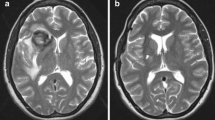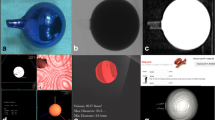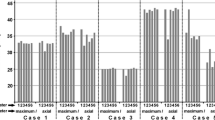Abstract
Background
Intracranial aneurysms (IA) are usually quantified according to their largest diameter. However, volumetry has recently been increasingly conducted as well, especially in giant intracranial aneurysms (GIAs). Since so far the true value of GIA volumetry is unknown, we designed a trial to examine correlations between GIA diameter and volume with special focus on clinical implications.
Methods
Magnetic resonance imaging of 69 unruptured GIAs in 66 patients was retrospectively evaluated. The largest diameter and volume were measured. Also, potential associations to the patients’ clinical conditions were examined.
Results
Comparing GIA sizes of our patient cohort produced different results depending on whether GIA diameter or volume was measured. Measuring the diameter identified posterior circulation GIAs as the largest ones (39.2 mm, IQR 37.3–48.3), while measuring the volume found GIAs of the MCA to be the largest ones (12.3 cm3, IQR 7.2–27.8). A correlation of GIA diameter and volume was only found in anterior circulation GIAs, which were predominantly saccular in shape, but not in those of the posterior circulation, of which most were fusiform. Neither GIA diameter nor GIA volume but only GIA location was associated with neurological deficits.
Conclusion
Diameter and volume measurements are not interchangeable modes of GIA quantification. Our data suggest that the idea of distinguishing different sizes of GIA may be clinically less relevant than examining their location, shape or mass effect.



Similar content being viewed by others
References
Carneiro A, Rane N, Küker W, Cellerini M, Corkill R, Byrne JV (2014) Volume changes of extremely large and giant intracranial aneurysms after treatment with flow diverter stents. Neuroradiology 56:51–58
Cebral JR, Raschi M (2013) Suggested connections between risk factors of intracranial aneurysms: a review. Ann Biomed Eng 41:1366–1383
Dengler J, Heuschmann PU, Endres M, Meyer B, Rohde V, Rufenacht DA, Vajkoczy P (2013) The rationale and design of the Giant Intracranial Aneurysm Registry: a retrospective and prospective study. Int J Stroke 6:266–270
de Rooij NK, Velthuis BK, Algra A, Rinkel GJ (2009) Configuration of the circle of Willis, direction of flow and shape of the aneurysm as risk factors for rupture of intracranial aneurysms. J Neurol 256:45–50
Kitagawa A, Mastracci TM, von Allmen R, Powell JT (2013) The role of diameter versus volume as the best prognostic measurement of abdominal aortic aneurysms. J Vasc Surg 58:258–265
Krings T, Alvarez H, Reinacher P, Ozanne A, Baccin CE, Gandolfo C, Zhao WY, Reinges MH, Lasjaunias P (2007) Growth and rupture mechanism of partially thrombosed aneurysms. Interv Neuroradiol 13:117–126
Larrabide I, Geers AJ, Morales HG, Aguilar ML, Rüfenacht DA (2014) Effect of aneurysm and ICA morphology on hemodynamics before and after flow diverter treatment. J Neurointerv Surg. doi:10.1136/neurintsurg-2014-011171
Macdonald DR, Cascino TL, Schold SC Jr, Cairncross JG (1990) Response criteria for phase II studies of supratentorial malignant glioma. J Clin Oncol 8:1277–1280
Mandonnet E, Delattre JY, Tanguy ML, Swanson KR, Carpentier AF, Duffau H, Cornu P, Van Effenterre R, Alvord EC Jr, Capelle L (2013) Continuous growth of mean tumor diameter in a subset of grade II gliomas. Ann Neurol 53:524–528
Nurminen V, Lehecka M, Chakrabarty A, Kivisaari R, Lehto H, Niemelä M, Hernesniemi J (2014) Anatomy and morphology of giant aneurysms–angiographic study of 125 consecutive cases. Acta Neurochir 156:1–10
Parr A, Jayaratne C, Buttner P, Golledge J (2011) Comparison of volume and diameter measurement in assessing small abdominal aortic aneurysm expansion examined using computed tomographic angiography. Eur J Radiol 79:42–47
Rees J, Watt H, Jäger HR, Benton C, Tozer D, Tofts P, Waldman A (2009) Volumes and growth rates of untreated adult low-grade gliomas indicate risk of early malignant transformation. Eur J Radiol 72:54–64
Sadato A, Hayakawa M, Tanaka T, Hirose Y (2011) Comparison of cerebral aneurysm volumes as determined by digitally measured 3D rotational angiography and approximation from three diameters. Interv Neuroradiol 17:154–158
van den Bent MJ, Wefel JS, Schiff D, Taphoorn MJ, Jaeckle K, Junck L, Armstrong T, Choucair A, Waldman AD, Gorlia T, Chamberlain M, Baumert BG, Vogelbaum MA, Macdonald DR, Reardon DA, Wen PY, Chang SM, Jacobs AH (2011) Response assessment in neuro-oncology (a report of the RANO group): assessment of outcome in trials of diffuse low-grade gliomas. Lancet Oncol 12:583–593
van Keulen JW, van Prehn J, Prokop M, Moll FL, van Heerwaarden JA (2009) Potential value of aneurysm sac volume measurements in addition to diameter measurements after endovascular aneurysm repair. J Endovasc Ther 16:506–513
von Allmen RS, Powell JT (2013) Part two: against the motion. External diameter for AAA size. Eur J Vasc Endovasc Surg 46:6–8
Wever JJ, Blankensteijn JD, Th M, Mali WP, Eikelboom BC (2000) Maximal aneurysm diameter follow-up is inadequante after endovascular abdominal aortic aneurysm repair. Eur J Vasc Endovasc Surg 20:177–182
Wiebers DO, Whisnant JP, Huston J 3rd, Meissner I, Brown RD Jr, Piepgras DG, Forbes GS, Thielen K, Nichols D, O’Fallon WM, Peacock J, Jaeger L, Kassell NF, Kongable-Beckman GL, Torner JC (2003) Unruptured intracranial aneurysms: natural history, clinical outcome, and risks of surgical and endovascular treatment. Lancet 362:103–110
Acknowledgments
The Giant Intracranial Aneurysm Registry is funded by the Center for Stroke Research-Berlin. The grant number is “CS-2009-12”
Clinical Trial Registration-URL:
http://www.clinicaltrials.gov. Unique identifier: NCT02066493.
Conflicts of interest
None.
Author information
Authors and Affiliations
Consortia
Corresponding author
Additional information
Comment
This is a concise report on analyses of 2D diametric and volumetric measurement of intracranial giant aneurysms and their correlation with patients’ symptoms. Although this study does not alter in any way or shape the clinical management of those complex aneurysms, it shows the discrepancy between size and volume in posterior circulation giant aneurysms (most likely due to more fusiform shape) and the fact that location but not the size or volume is the only indicator of symptomatic aneurysms in this population.
Amir Dehdashti
NY,USA
No parts of this project have been presented anywhere before.
The Giant Aneurysm Study Group (November 2014)
The Giant Aneurysm Study Group (November 2014)
Vajkoczy P, Uebelacker A, Maldaner N, Dengler J
Department of Neurosurgery, Charité – Universitaetsmedizin Berlin
Endres M
Department of Neurology, Charité – Universitaetsmedizin Berlin
Bohner G, Wiener E, Bauknecht HC
Department of Neuroradiology, Charité – Universitaetsmedizin Berlin
Heuschmann PU, Malzahn U
Institute of Clinical Epidemiology and Biometry, University of Würzburg
Glaesker S, Zentner J, Van Velthoven V
Department of Neurosurgery, University Hospital Freiburg, Germany
Guhl S, Schroeder HWS
Department of Neurosurgery, University of Greifswald, Germany
Strowitzki M
Department of Neurosurgery, Trauma Center Murnau, Murnau, Germany
Etminan N, Haengghi D, Eicker S, Turowski B
Department of Neurosurgery, University of Düsseldorf, Germany
Schebesch KM, Brawanski A
Department of Neurosurgery, University of Regensburg, Germany
Wrede K, Sure U
Department of Neurosurgery, University of Essen, Germany
Schmidt NO, Regelsberger J, Westphal M
Department of Neurosurgery, University Medical Center, Hamburg Eppendorf, Germany
Mielke D, Rohde V
Department of Neurosurgery, Georg-August-University Goettingen, Germany
Hosch H, Moskopp D
Department of Neurosurgery Vivantes-Klinikum im Friedrichshain, Berlin, Germany
Joedicke A
Department of Neurosurgery Vivantes-Klinikum Neukoelln, Berlin, Germany
Hohaus C, Meisel HJ
Department of Neurosurgery, BG-Clinic Bergmannstrost, Halle, Germany.
Wostrack M, Meyer B, Lehmberg J
Department of Neurosurgery, Technical University of Munich, Germany
Musahl C, Hopf N
Department of Neurosurgery, Klinikum Stuttgart, Stuttgart, Germany
Winkler G, Spetzger U
Department of Neurosurgery, Klinikum Karlsruhe, Germany
Graewe A, Meier U
Department of Neurosurgery, Unfallkrankenhaus Berlin, Germany
Hong B, Nakamura M, Krauss J
Department of Neurosurgery, Hannover Medical School, Hannover, Germany
Grote A, Simon M, Schramm J
Department of Neurosurgery, University Hospital Bonn, Bonn, Germany
Kursumovic A, Rath SA
Department of Neurosurgery and Interventional Neuroradiology, Donau-Isar-Klinikum,
Deggendorf, Germany
Walter J, Kalff R
Department of Neurosurgery, Friedrich-Schiller-University, Jena, Germany
Marbacher S, Fathi A, Fandino J
Department of Neurosurgery, Kantonsspital Aarau, Aarau, Switzerland,
Familiari P, Raco A
Department of Neurosurgery, University of Rome “Sapienza”, Rome, Italy
Bijlenga P, Schaller K
Service de Neurochirurgie, Faculté de Médecine de Genève and Hôpitaux Universitaire de Genève, Switzerland
Gruber A, Wang WT, Knosp E
Department of Neurosurgery, Medical University Vienna, Vienna, Austria
Hoffmann KT, Boxhammer E
Department of Neuroradiology, University of Leipzig, Leipzig, Germany
Rüfenacht DA
Department of Neuroradiology, Klinik Hirslanden, Zurich, Switzerland
Boccardi E, Piano M
Department of Neuroradiology, Ospedale Niguarda Ca’ Granda, Milano, Italy
Niemelä M, Nurminen V, Lehecka M, Hernesniemi J
Department of Neurosurgery, Helsinki University Central Hospital, Helsinki, Finland
Burkhardt JK, Bozinov O, Regli L
Department of Neurosurgery, University Hospital of Zurich, Switzerland
Shekhtman OD, Eliava SS
Burdenko Neurosurgical Institute, Russian Academy of Medical Sciences, Moscow, Russia
Kato N, Irie K, Nishimura K, Kaku S, Arakawa H, Yuki I, Ishibashi T, Murayama Y
Department of Neurosurgery, Jikei University School of Medicine, Tokyo, Japan
Fiss I, Kombos T
Department of Spine Surgery and Neurosurgery, Helios Klinikum Hildesheim, Hildesheim, Germany
van der Zwan A, van Doormaal TP
Department of Neurosurgery, University Medical Center Utrecht, Utrecht, Netherlands
Cognard C, Gawlitza M
Department of Neuroradiology, Toulouse University Hospital, Toulouse, France
Rights and permissions
About this article
Cite this article
Dengler, J., Maldaner, N., Bijlenga, P. et al. Quantifying unruptured giant intracranial aneurysms by measuring diameter and volume—a comparative analysis of 69 cases. Acta Neurochir 157, 361–368 (2015). https://doi.org/10.1007/s00701-014-2292-5
Received:
Accepted:
Published:
Issue Date:
DOI: https://doi.org/10.1007/s00701-014-2292-5




